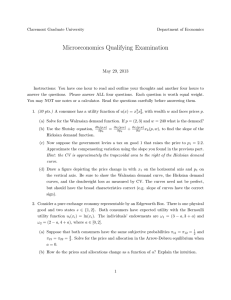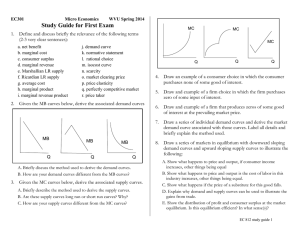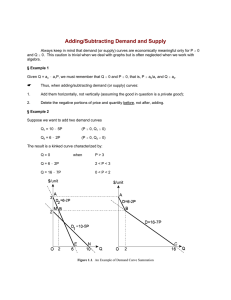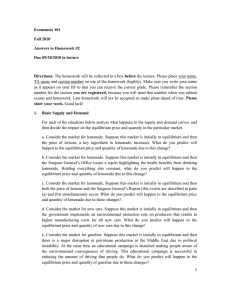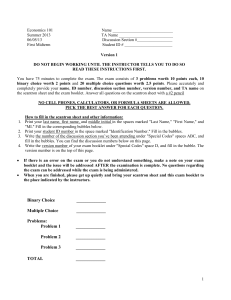Economics 103 Lecture # 7 Demand, Exchange, Equilibrium
advertisement
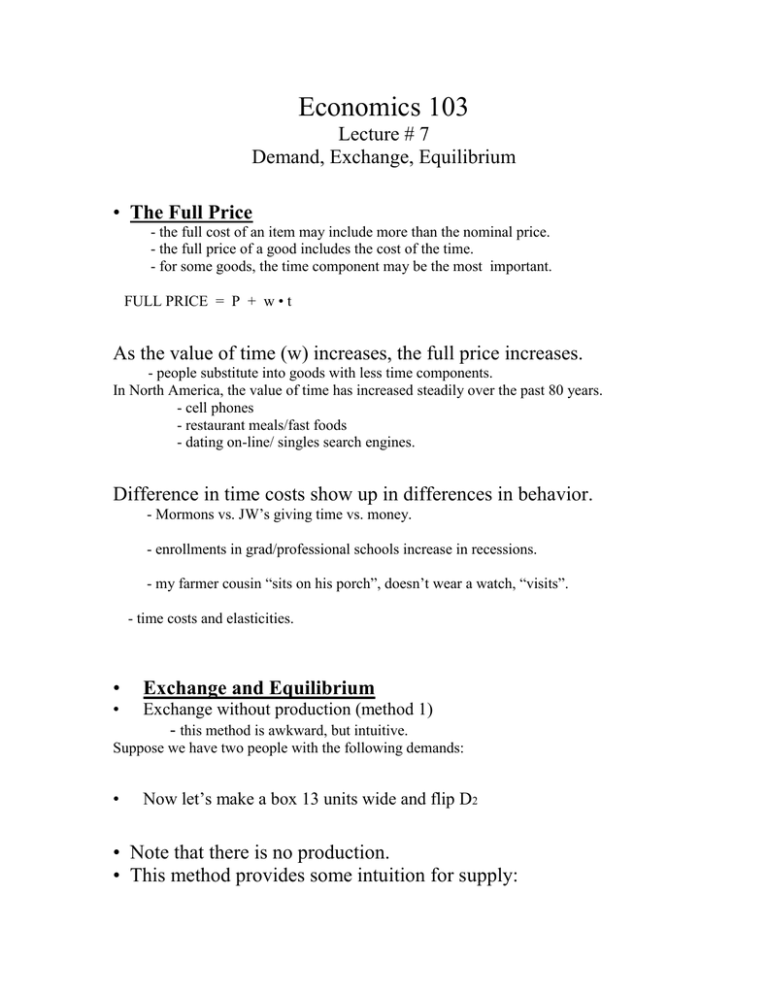
Economics 103 Lecture # 7 Demand, Exchange, Equilibrium • The Full Price - the full cost of an item may include more than the nominal price. - the full price of a good includes the cost of the time. - for some goods, the time component may be the most important. FULL PRICE = P + w • t As the value of time (w) increases, the full price increases. - people substitute into goods with less time components. In North America, the value of time has increased steadily over the past 80 years. - cell phones - restaurant meals/fast foods - dating on-line/ singles search engines. Difference in time costs show up in differences in behavior. - Mormons vs. JW’s giving time vs. money. - enrollments in grad/professional schools increase in recessions. - my farmer cousin “sits on his porch”, doesn’t wear a watch, “visits”. - time costs and elasticities. • Exchange and Equilibrium • Exchange without production (method 1) - this method is awkward, but intuitive. Suppose we have two people with the following demands: • Now let’s make a box 13 units wide and flip D2 • Note that there is no production. • This method provides some intuition for supply: • Exchange and Equilibrium B) Exchange without production (method 2) • Suppose they have the following demands. Price: 10 Davie Quantity: 0 Petey Quantity: 0 Total Demanded 0 9 8 7 6 5 4 3 2 1 1 2 3 4 5 6 7 8 9 0 0 1 2 3 4 5 6 7 1 2 4 6 8 10 12 14 16 • This is called a Market Demand Curve • Note that the market demand curve is more elastic than the individual demand curves. Aside: Unit Demand Curves • What would happen if there were goods that only had 0/1 choices. Either you were in, or out of the market. -in this course or not - student or working - getting pregnant - committing murder or other crimes. - buying a house, car, or other large ticket item etc. • At the market level, nothing happens! - all you have, however, is an extensive margin • The advantage of this is we can talk about a market demand curve for discrete behavior. - the concept of the marginal consumer. - Does a reduction in the punishment for murder mean that everyone will commit a murder? - if the government introduces a baby bonus, does everyone have a baby? - change the divorce law and only some divorce. • Back to our Market Demand. In order to find the equilibrium we need to find the Market Supply. • Now we put the Market Demand and Supply Together. • Why is this an equilibrium. • When one of the houses burns down: • • • • • • Do they trade after the fire? Who is made better off, worse off? Who profits from the fire? Is this fair? Is this efficient? What does efficiency mean? What would happen if we prevented this type of opportunism? Applications 1. Equilibrium a) Scarcity. b) “Eventual shortages” Or like this: They are all, basically, examples of: c) What is wrong with this picture: 2. Suppose there was a drought Generally, how will changes in supply and demand influence price and quantity? 3. Why have North American’s had a love affair with big cars? In the 1970s GMC invented the Chevette: • An important factor is the price of gas. -Europe has higher gas prices due to taxes. At times the price has been 5-10 times higher. - Over time the price of gas has changed a great deal in North America. 4. The effect of the “baby boom”. • So the boomers were teens in the 60s, 30something in the 80s, and now they are approaching retirement. • The Marriage Squeeze (brief example of non-market application) 5. Interference in the market. a) Rent Control. b) Minimum wage 6. Costly trading







